Douglas A-1 Skyraider
| A-1 (AD) Skyraider | |
|---|---|
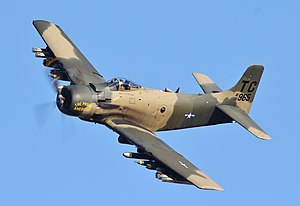 | |
| General information | |
| Type | Attack aircraft |
| National origin | United States |
| Manufacturer | Douglas Aircraft Company |
| Primary users | United States Navy |
| Number built | 3,180 |
| History | |
| Manufactured | 1945–1957 |
| Introduction date | 1946 |
| First flight | 18 March 1945 |
| Retired | 1973 (US use) 1985 (Gabonese Air Force)[1] |
| Developed into | Douglas A2D Skyshark |
TheDouglas A-1 Skyraider(formerly designatedADbefore the 1962unification of Navy and Air Force designations) is an American single-seatattack aircraftin service from 1946 to the early 1980s, which served during theKorean WarandVietnam War.The Skyraider had an unusually long career, remaining in frontline service well into theJet Age(when mostpiston-engine attack or fighter aircraft were replaced byjet aircraft); thus becoming known by some as an "anachronism".[2][3]The aircraft was nicknamed "Spad", after theFrench World War I fighter.[4]
It was operated by theUnited States Navy(USN), theUnited States Marine Corps(USMC), and theUnited States Air Force(USAF), and also saw service with the BritishRoyal Navy,theFrench Air Force,theRepublic of Vietnam Air Force(RVNAF), and others. It remained in U.S. service until the early 1970s.
Design and development
[edit]The piston-engined,propeller-drivenSkyraider was designed during World War II to meet United States Navy requirements for acarrier-based,single-seat, long-range, high performancedive/torpedo bomber,to follow on from earlier aircraft such as theDouglas SBD Dauntless,theCurtiss SB2C Helldiverand theGrumman TBF Avenger.[5]Designed byEd Heinemannof theDouglas Aircraft Company,prototypes were ordered on 6 July 1944 as theXBT2D-1.The XBT2D-1 made its first flight on 18 March 1945, and the USN began evaluation of the aircraft at theNaval Air Test Center(NATC) in April 1945.[6]In December 1946, after a designation change toAD-1,delivery of the first production aircraft to a fleet squadron was made to VA-19A.[7]
The AD-1 was built at Douglas'sEl Segundoplant in Southern California. In his memoirThe Lonely Sky,test pilotBill Bridgemandescribed the routine yet sometimes hazardous work of certifying AD-1s fresh off the assembly line at a rate of two aircraft per day for delivery to the U.S. Navy in 1949 and 1950.[8]

The low-wing monoplane design started with aWright R-3350 Duplex-Cycloneradial enginewhich was later upgraded several times. The aircraft had distinctive large straight wings with sevenhardpointsapiece. The Skyraider had excellent maneuverability at low speed, and carried a large amount ofordnanceover a considerable combat radius. It had a long loiter time for its size, compared to much heavier subsonic or supersonic jets. The aircraft was optimized for ground attack and was armored against ground fire in key locations, unlike faster fighters adapted to carry bombs, such as theVought F4U CorsairorNorth American P-51 Mustang,which were retired by U.S. forces before the 1960s.
Shortly after Heinemann began designing the XBT2D-1, a study was issued showing that for every 100 lb (45 kg) of weight reduction, the takeoff run was decreased by 8 ft (2.4 m), the combat radius increased by 22 mi (35 km) and the rate-of-climb increased by 18 ft/min (0.091 m/s). Heinemann immediately had his design engineers begin a program for finding weight savings on the XBT2D-1 design, no matter how small. Simplifying the fuel system resulted in a reduction of 270 lb (120 kg); 200 lb (91 kg) by eliminating an internal bomb bay and hanging external stores from the wings or fuselage; 70 lb (32 kg) by using a fuselage dive brake; and 100 lb (45 kg) by using an older tailwheel design. In the end, Heinemann and his design engineers achieved more than 1,800 lb (820 kg) of weight reduction on the original XBT2D-1 design.[9]
The Navy AD series was initially painted in ANA 623 glossy sea blue, but during the 1950s, following the Korean War, the color scheme was changed to light gull grey and white (Fed Std 595 27875). Initially using the gray and white Navy scheme, by 1967 the USAF began to paint its Skyraiders in a camouflaged pattern using two shades of green, and one of tan.

Used by the US Navy over Korea and Vietnam, the A-1 was a primary close air support aircraft for the USAF and RVNAF during the Vietnam War. The A-1 was famous for being able to take hits and keep flying thanks to armor plating around the cockpit area for pilot protection. It was replaced beginning in the mid-1960s by theGrumman A-6 Intruderas the Navy's primary medium-attack plane insupercarrier-based air wings; however Skyraiders continued to operate from the smallerEssex-class aircraft carriers.
The Skyraider went through seven versions, starting with theAD-1,thenAD-2andAD-3with various minor improvements, then theAD-4with a more powerfulR-3350-26WAengine. TheAD-5was significantly widened, allowing two crew to sit side-by-side (this was not the first multiple-crew variant, theAD-1Qbeing a two-seater and theAD-3Na three-seater); it also came in a four-seat night-attack version, theAD-5N.TheAD-6was an improved AD-4B with improved low-level bombing equipment, and the final production versionAD-7was upgraded to anR-3350-26WBengine.
For service in Vietnam, USAF Skyraiders were fitted with the Stanley Yankee extraction system,[10]which acted in a similar manner to an ejection seat, though with twin rockets extracting the pilot from the cockpit.
In addition to serving during Korea and Vietnam as an attack aircraft, the Skyraider was modified to serve as a carrier-based airborne early warning aircraft, replacing theGrumman TBM-3W Avenger.It fulfilled this function in the USN andRoyal Navy,being replaced by theGrumman E-1 TracerandFairey Gannet,respectively, in those services.[11]
Skyraider production ended in 1957 with a total of 3,180 having been built. In 1962, the existing Skyraiders were redesignatedA-1DthroughA-1Jand later used by both theUSAFand theNavyin the Vietnam War.
Operational history
[edit]Korean War
[edit]
The Skyraider was produced too late for use in World War II, but became the backbone of United States Navy aircraft carrier and United States Marine Corps strike aircraft sorties in theKorean War(1950–1953), with the first ADs going into action fromValley ForgewithVA-55on 3 July 1950.[12]Its weapons load and 10-hour flying time far surpassed the jets that were available at the time.[11]On 2 May 1951, Skyraiders made the onlyaerial torpedoattack of the war, hitting theHwacheon Dam,then controlled by North Korea.[13]
On 16 June 1953, a USMC AD-4 fromVMC-1piloted byMajorGeorge H. Linnemeier and CWO Vernon S. Kramer shot down a Soviet-builtPolikarpov Po-2biplane, the only documented Skyraider air victory of the war.[14]AD-3N and -4N aircraft carrying bombs and flares, flew night-attack sorties, and radar-equipped ADs carried out radar-jamming missions from carriers and land bases.[11]
During the Korean War, AD Skyraiders were flown by only the U.S. Navy and U.S. Marine Corps, and were normally painted in dark navy blue. It was called the "Blue Plane" by enemy troops.[15]Marine Corps Skyraiders suffered heavy losses when used in low-level close-support missions. To allow low-level operations to continue without unacceptable losses, a package of additional armor was fitted, consisting of 0.25–0.5 inches (6.4–12.7 mm) thick external aluminum armor plates fitted to the underside and sides of the aircraft's fuselage. The armor package weighed a total of 618 pounds (280 kg) and had little effect on performance or handling.[16]A total of 128 Navy and Marine AD Skyraiders were lost in the Korean War – 101 in combat and 27 to operational causes. Most operational losses were due to the tremendous power of the AD: ADs that were "waved-off" during carrier recovery operations were prone to performing a fatal torque roll into the sea or the deck of the aircraft carrier if the pilot mistakenly gave the AD too much throttle. The torque of the engine was so great that it would cause the aircraft to rotate about the propeller and slam into the sea or the carrier.
Cathay Pacific VR-HEU incident
[edit]On 26 July 1954, two Douglas Skyraiders from the aircraft carriersUSSPhilippine SeaandHornetshot down twoChinesePLAAFLavochkin fightersoff the coast ofHainan Islandwhile searching for survivors after theshooting down of a Cathay Pacific Douglas DC-4 Skymasterairliner three days previously.[17][18][19]
Vietnam War
[edit]
As American involvement in theVietnam Warbegan, the A-1 Skyraider was still the medium attack aircraft in manycarrier air wings,although it was planned to be replaced by theA-6A Intruderas part of the general switch to jet aircraft. Skyraiders fromConstellationandTiconderogaparticipated in the first U.S. Navy strikes againstNorth Vietnamon 5 August 1964 as part ofOperation Pierce Arrowin response to theGulf of Tonkin Incident,striking against fuel depots atVinh,with one Skyraider fromTiconderogadamaged byanti-aircraft fire,and a second fromConstellationshot down, killing its pilot, Lieutenant Richard Sather.[20][21]
Shoot-downs
[edit]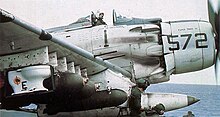
During the war, U.S. Navy Skyraiders used their cannon to shoot down twoVietnam People's Air Force(VPAF)Mikoyan-Gurevich MiG-17jet fighters. The first, on 20 June 1965 byLieutenantClinton B. Johnson andLt. (jg)Charles W. Hartman III ofVA-25,[22]was the first gun kill of the Vietnam War. The other was on 9 October 1966 by Lt. (jg) William T. Patton ofVA-176.[14]
Tactical operators
[edit]As they were released from U.S. Navy service, Skyraiders were introduced into theRepublic of Vietnam Air Force(RVNAF). Skyraiders were also used by theU.S. Air Force,specifically Special Operations elements of theTactical Air Command,for search and rescue air cover. They were also used by the USAF to perform one of the Skyraider's most famous roles — the "Sandy" helicopter escort on combat rescues.[23][24]On 10 March 1966, USAFMajorBernard F. Fisherflew an A-1E mission and was awarded theMedal of Honorfor rescuing Major "Jump" Myers atA ShauSpecial ForcesCamp.[25]USAFColonelWilliam A. Jones IIIpiloted an A-1H on 1 September 1968 mission for which he was awarded the Medal of Honor. In that mission, despite damage to his aircraft and suffering serious burns, he returned to his base and reported the position of a downed U.S. airman.[25]
Losses
[edit]On 5 August 1964, the first A-1H Skyraider was shot down duringOperation Pierce Arrow.The pilot, Lt. (jg) Richard Sather, was the first Navy pilot killed in the war. On the night of 29 August 1964, an A-1E Skyraider was shot down and the pilot killed nearBien Hoa Air Base;it was flown by Capt. Richard D. Goss from the1st Air Commando Squadron,34th Tactical Group. The third A-1 was shot down on 31 March 1965 piloted by Lt. (jg) Gerald W. McKinley from theUSSHancockon a bombing run over North Vietnam. He was reported missing, presumed dead.
While on his first mission, Navy pilot Lt. (jg)Dieter Denglertook damage to his A-1J over Vietnam on 1 February 1966, and crash-landed inLaos.[26]
Col. Oscar Mauterer ejected from his A-1 after taking heavy enemy fire while providing cover for a damaged friendly aircraft on February 15, 1966. Radio reports confirmed Mauterer had a good chute, but was captured by enemy forces. Mauterer is still POW/MIA status.

The next A-1 was shot down on 29 April 1966, and Pilot Capt. Grant N. Tabor, was lost on 19 April 1967; both were from the602 Air Commando Squadron.A Skyraider from Navy SquadronVA-25on a ferry flight fromNaval Air Station Cubi Point(Philippines) toUSSCoral Seawas lost to two Chinese MiG-17s on 14 February 1968: Lieutenant (jg) Joseph P. Dunn, USN flew too close to the Chinese island ofHainanand was intercepted. Lieutenant Dunn's A-1H Skyraider 134499 (Canasta 404) was the last Navy A-1 lost in the war. He was observed to survive the ejection and deploy his raft, but was never found. Initially listed as missing in action, he is now listed as killed in action and posthumously promoted to the rank of Commander. In October 1965, to highlight the dropping of the six millionth pound of ordnance,CommanderClarence J. Stoddard of VA-25, flying an A-1H, dropped a special, one-time-only object in addition to his other munitions – a toilet.[27]During the Vietnam War, the U.S. Navy lost 65 Skyraiders, 48 of these in combat.[28]
The U.S. Air Force used the naval A-1 Skyraider for the first time in Vietnam. As the Vietnam War progressed, USAF A-1s were painted incamouflage,while USN A-1 Skyraiders were gray/white in color in contrast to the Korean War, when A-1s were painted dark blue. After November 1972, all A-1s in U.S. service inSoutheast Asiawere transferred to the RVNAF. The Skyraider in Vietnam pioneered the concept of tough, survivable aircraft with long loiter times and large ordnance loads. The USAF lost 191 Skyraiders in Southeast Asia, 150 of these in combat. Of the combined total of 256 lost A-1s, five were shot down bysurface-to-air missiles(SAMs), and three were shot down in air-to-air combat; the rest were shot down byanti-aircraft artillery.[29]
Republic of Vietnam Air Force
[edit]The A-1 Skyraider was the close air support workhorse of the RVNAF for much of the Vietnam War. The U.S. Navy began to transfer some of its Skyraiders to the RVNAF in September 1960, replacing the RVNAF's olderGrumman F8F Bearcats.By 1962 the RVNAF had 22 of the aircraft in its inventory,[30]and by 1968 an additional 131 aircraft had been received. Initially Navy aviators and crews were responsible for training their South Vietnamese counterparts on the aircraft, but over time responsibility was gradually transferred to the USAF.

The initial trainees were selected from among RVNAF Bearcat pilots who had accumulated 800 to 1200 hours flying time. They were trained atNAS Corpus Christi,Texas, and then sent toNAS Lemoore,California for further training. Navy pilots and crews in Vietnam checked out the Skyraiders that were being transferred to the RVNAF, and conducted courses for RVNAF ground crews.[31]
Over the course of the war, the RVNAF acquired a total more than 350 Skyraiders, and was operating six A-1 squadrons by the end of 1965. About one third of these were A-1E/G. These were reduced during the period ofVietnamizationfrom 1968 to 1972, as the U.S. began to supply the South Vietnamese with more modern close air support aircraft, such as theA-37 DragonflyandNorthrop F-5,and at the beginning of 1968, only three of its squadrons were flying A-1s.[32]
As the U.S. ended its direct involvement in the war, it transferred the remainder of its Skyraiders to the South Vietnamese, and by 1973, all remaining Skyraiders in U.S. inventories had been turned over to the RVNAF.[33]Unlike their American counterparts, whose combat tours were generally limited to 12 months, individual South Vietnamese Skyraider pilots ran up many thousands of combat hours in the A-1, and many senior RVNAF pilots were extremely skilled in the operation of the aircraft.[34]The last Skyraiders transferred to the VNAF were 23 A-1H/J and 21 A-1E/G in late 1972. In 1974, 61 were put in storage. A year later, eleven fled to Thailand (5 A-1E, 1 A-1G, 5 A-1H) and more than 40 were captured by North Vietnam.[35]
A-1H 134600 was operated by the VNAF from 1965 to 1975. In 1997, it was acquired by the U. S. Army Center of Military History before it was restored and put on display at the National Museum of the USAF in 2022 (painted as 52–139738).[36]
United Kingdom
[edit]
TheRoyal Navyacquired 50 AD-4W early warning aircraft in 1951 through theMilitary Assistance Program.All Skyraider AEW.1s were operated by849 Naval Air Squadron,which provided four-plane detachments for the British carriers. Flights fromHMSEagle(R05)andHMSAlbion(R07)took part in theSuez Crisisin 1956.[37][38]778 Naval Air Squadronwas responsible for the training of the Skyraider crews atRNAS Culdroseuntil July 1952.[39]
In 1960, theFairey Gannet AEW.3replaced the Skyraiders, using theAN/APS-20radar of the Douglas aircraft. The last British Skyraiders were retired in 1962.[39]In the late 1960s, the AN/APS-20 radars from the Skyraiders were installed inAvro Shackleton AEW.2sof theRoyal Air Forcewhich were finally retired in 1991.
Sweden
[edit]Fourteen ex-British AEW.1 Skyraiders were sold to Sweden to be used bySvensk Flygtjänst ABbetween 1962 and 1976. All military equipment was removed and the aircraft were used astarget tugssupporting theSwedish Armed Forces.[39]
France
[edit]TheFrench Air Forcebought 20 ex-USN AD-4s as well as 88 ex-USN AD-4Ns and five ex-USN AD-4NAs with the former three-seaters modified as single-seat aircraft with removal of the radar equipment and the two operator stations from the rear fuselage. The AD-4N/NAs were initially acquired in 1956 to replace agingRepublic P-47 Thunderboltsin Algeria.[40]
The Skyraiders were first ordered in 1956 and the first was handed over to the French Air Force on 6 February 1958 after being overhauled and fitted with some French equipment by Sud-Aviation. The aircraft were used until the end of theAlgerian War.The aircraft were used by the 20eEscadre de Chasse(EC 1/20 "Aures Nementcha", EC 2/20 "Ouarsenis" and EC 3/20 "Oranie" ) and EC 21 in the close air support role armed with rockets, bombs andnapalm.
The Skyraiders had only a short career in Algeria, but they nonetheless proved to be the most successful of all the ad hoccounter-insurgency aircraftdeployed by the French. The Skyraider remained in limited French service until the 1970s.[40]They were heavily involved in the civil war in Chad, at first with theArmée de l'Air,and later with a nominally independentChadian Air Forcestaffed by French mercenaries. The aircraft also operated under the French flag in Djibouti and on the island of Madagascar. When France at last relinquished the Skyraiders it passed the survivors on to allied states, including Gabon,Chad,Cambodiaand theCentral African Republic[41](several aircraft from Gabon and Chad were recovered by French warbird enthusiasts and entered on the French civil register).
The French frequently used the aft station to carry maintenance personnel, spare parts and supplies to forward bases. In Chad they even used the aft station for a "bombardier" and his "special stores" – empty beer bottles – as these were considered asnon-lethal weapons,thus not breaking the government-imposed rules of engagement, during operations against Libyan-supported rebels in the late 1960s and early 1970s.[citation needed]
Variants
[edit]
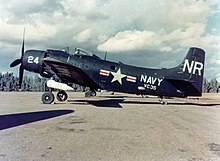

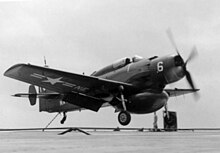
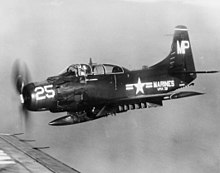


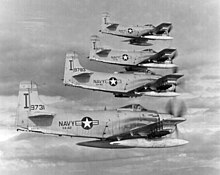
- XBT2D-1
- Single-seat dive-bomber, torpedo-bomber prototype for the U.S. Navy
- XBT2D-1N
- Three-seat night attack prototypes; only three aircraft built
- XBT2D-1P
- Photographic reconnaissance prototype; only one built
- XBT2D-1Q
- Two-seat electronics countermeasures prototype; one aircraft only
- BT2D-2 (XAD-2)
- Upgraded attack aircraft; one prototype only
- AD-1
- The first production model; 242 built
- AD-1Q
- Two-seat electronic countermeasures version of the AD-1; 35 built
- AD-1U
- AD-1 with radar countermeasures and tow target equipment, no armament and nowater injectionequipment
- XAD-1W
- Three-seat airborne early warning prototype. AD-3W prototype; one aircraft only.
- AD-2
- Improved model, powered by 2,700 hp (2,000 kW) Wright R-3350-26W engine; 156 built
- AD-2D
- Unofficial designation for AD-2s used as remote-control aircraft, to collect and gather radioactive material in the air after nuclear tests
- AD-2Q
- Two-seat electronics countermeasures version of the AD-2; 21 built
- AD-2QU
- AD-2 with radar countermeasures and target towing equipment, no armament and no water injection equipment; one aircraft only
- XAD-2
- Similar to XBT2D-1 except engine, increased fuel capacity
- AD-3
- Proposed turboprop version, initial designation ofA2D Skyshark
- AD-3
- Stronger fuselage, improved landing gear, new canopy design; 125 built
- AD-3S
- Anti-submarine warfare model; only two prototypes were built
- AD-3N
- Three-seat night attack version; 15 built
- AD-3Q
- Electronics countermeasures version, countermeasures equipment relocated for better crew comfort; 23 built
- AD-3QU
- Target towing aircraft, but most were delivered as AD-3Qs
- AD-3W
- Airborne early warning version; 31 built
- XAD-3E
- AD-3W modified for ASW with Aeroproducts propeller
- AD-4
- Strengthened landing gear, improved radar, G-2 compass, anti-G suit provisions, four 20 mm (0.79 in) cannon and 14 Aero rocket launchers; 372 built
- AD-4B
- Specialized version designed to carry nuclear weapons, also armed with four 20 mm (0.79 in) cannon; 165 built plus 28 conversions
- AD-4L
- Equipped for winter operations in Korea; 63 conversions
- AD-4N (A-1D)
- Three-seat night attack version; 307 built
- AD-4NA
- Designation of 100 AD-4Ns without their night-attack equipment, but fitted with four 20 mm cannon, for service in Korea as ground-attack aircraft
- AD-4NL
- Winterized version of the AD-4N; 36 conversions
- AD-4Q
- Two-seat electronic countermeasures version of the AD-4; 39 built
- AD-4W
- Three-seat airborne early warning version; 168 built. A total of 50 AD-4Ws were transferred to the Royal Navy asSkyraider AEW Mk 1s.
- AD-5 (A-1E)
- Side-by-side seating for pilot and co-pilot, without dive brakes; 212 built; During the Vietnam War, many retiredSkyraiders were refurbished for the U.S. Air Force and the Vietnamese Air Force. AD-5/-5Q/-5W aircraft became "new" USAF A-1E attack aircraft.
- AD-5N (A-1G)
- Four-seat night attack version, with radar countermeasures; 239 built; A-1G was the U.S. Air Force designation for refurbished AD-5N.
- AD-5Q (EA-1F)
- Four-seat electronics countermeasures version; 54 conversions
- AD-5S
- One prototype to testmagnetic anomaly detector(MAD) anti-submarine equipment
- AD-5U
- The AD-5 when modified for target towing became the UA-1E in 1962. The same model converted as a transport was sometimes referred to as the AD-5R.
- AD-5W (EA-1E)
- Three-seat airborne early warning version with anAN/APS-20radar installed; 218 were built
- UA-1E
- Utility version of the AD-5
- AD-6 (A-1H)
- Single-seat attack aircraft with three dive brakes, centerline station stressed for 3,500 lb (1,600 kg) of ordnance, 30 in (760 mm) in diameter, combination 14 in (360 mm) and 30 in (760 mm) bomb ejector and low/high altitude bomb director; 713 built
- AD-7 (A-1J)
- The final production model, powered by a R-3350-26WB engine, with structural improvements to increase wing fatigue life; 72 built
Operators
[edit] Cambodia
Cambodia Central African Republic
Central African Republic Chad
Chad France
France Gabon
Gabon South Vietnam
South Vietnam Sweden
Sweden United Kingdom
United Kingdom United States
United States
Surviving aircraft
[edit]Specifications (AD-6 / A-1H Skyraider)
[edit]
Data fromMcDonnell Douglas aircraft since 1920: Volume I[42]
General characteristics
- Crew:1
- Length:38 ft 10 in (11.84 m)
- Wingspan:50 ft 0.25 in (15.2464 m)
- Height:15 ft 8.25 in (4.7816 m)
- Wing area:400.33 sq ft (37.192 m2)
- Airfoil:root:NACA2417;tip:NACA 4413[43]
- Empty weight:11,968 lb (5,429 kg)
- Gross weight:18,106 lb (8,213 kg)
- Fuel capacity:380 US gal (320 imp gal; 1,400 L) internal tanks
- Powerplant:1 ×Wright R-3350-26WA Duplex-Cyclone18-cylinder air-cooled radial piston engine, 2,700 hp (2,000 kW)
- Propellers:4-bladedAeroproductsconstant-speed propeller
Performance
- Maximum speed:322 mph (518 km/h, 280 kn) at 18,000 ft (5,500 m)
- Cruise speed:198 mph (319 km/h, 172 kn)
- Range:1,316 mi (2,118 km, 1,144 nmi)
- Service ceiling:28,500 ft (8,700 m)
- Rate of climb:2,850 ft/min (14.5 m/s)
- Wing loading:46.6 lb/sq ft (228 kg/m2)
- Power/mass:0.149 hp/lb (0.245 kW/kg)
Armament
- Guns:4x 20 mmAN/M3 cannonwith 200 rounds per gun
- Hardpoints:15 external hardpoints with a capacity of 10,500 lbs (4762.71kg) per NAVWEPS manual 01-40-ALF-1, with provisions to carry combinations of:
- Other:bombs, torpedoes, mine dispensers, unguided rockets, and gun pods.[27]
Naming
[edit]The A-1 Skyraider received various nicknames including: "Spad" and "Super Spad" (derived from the aircraft's AD designation, its relative longevity in service and an allusion to the "Spad"aircraft of World War I)," Able Dog "(phonetic AD)," the Destroyer "," Hobo "(radio call sign of the US Air Force's1st Air Commando/1st Special Operations Squadron), "Firefly" (a call sign of the602nd ACS/SOS), "Zorro" (the call sign of the22nd SOS), "The Big Gun", "Old Faithful", "Old Miscellaneous", "Fat Face" (AD-5/A-1E version, side-by-side seating), "Guppy" (AD-5W version), "Q-Bird" or "Queer Bird" (AD-1Q/AD-5Q versions), "Flying Dumptruck" (A-1E), "Sandy" (the602nd ACS/SOScall sign for Combat Search And Rescue helicopter escort), and "Crazy Water Buffalo" (South Vietnamese nickname).[44][failed verification]
Notable appearances in media
[edit]See also
[edit]Related development
Aircraft of comparable role, configuration, and era
Related lists
References
[edit]Notes
[edit]- ^Thornburg, Chris."World Air Forces – Historical Listings: Gabon (GAB)."ArchivedJuly 4, 2011, at theWayback MachineWorldAirForces.Com,3 December 2006. Retrieved: 24 March 2011.
- ^Suciu, Peter (30 March 2021)."'Flying Anachronism': Douglas A-1 Skyraider Was a Vietnam War Warrior ".The National Interest.
- ^"Douglas A-1 Skyraider Registry - A Warbirds Resource Group Site".www.warbirdregistry.org.
- ^Burgess and Rausa 2009, p. 7.
- ^Parker, Dana T.Building Victory: Aircraft Manufacturing in the Los Angeles Area in World War II,p. 33, Cypress, Calif., 2013.ISBN978-0989790604.
- ^Bridgeman and Hazard 1955, pp. 38–40.
- ^"Headaches of a Jet Designer."Popular Mechanics,January 1953, pp. 81–85, 248.
- ^"The Ejection Site: Stanley YANKEE Extraction System".www.ejectionsite.com.Archivedfrom the original on 10 January 2002.Retrieved27 April2018.
- ^abcJohnson, E.R. "Able Dog."Aviation History,September 2008.
- ^Mersky 1983, p. 144.
- ^Faltum 1996, pp. 125–126.
- ^abGrossnick and Armstrong 1997
- ^Jordan, Corey C."Douglas AD-4 Skyraider."Archived2011-09-03 at theWayback MachineA Frozen Hell... The Air War Over Korea, 1950–1953,2001. Retrieved: 14 July 2011.
- ^De Vine, Carl R."Aluminum Armor Protects AD's"Archived2017-01-26 at theWayback Machine.Naval Aviation News,May 1953, p. 33.
- ^"From all Quarters: The Hainan Incident".Flight.Vol. 66, no. 2375. 30 July 1954. p. 130.
- ^"U.S. Alert to New Red Air Attacks".Aviation Week.Vol. 61, no. 5. 2 August 1954. p. 15.
- ^"Air Clash off Hainan."ArchivedDecember 19, 2008, at theWayback MachineSouth China Morning Post,27 July 1954.
- ^DorrAir Enthusiast1988, p. 3.
- ^Dorr and Bishop 1996, pp. 34–35.
- ^Johnson, Clinton."Skyraider vs Mig-17."Archived2007-11-28 at theWayback MachineUntold Stories.Retrieved: 14 July 2011.
- ^"Douglas A-1H and A-1J"ArchivedMarch 6, 2008, at theWayback Machine,National Museum of the United States Air Force. Retrieved: 30 December 2007.
- ^"Rescue in Vietnam."ArchivedMarch 6, 2008, at theWayback MachineNational Museum of the United States Air Force.Retrieved: 30 December 2007.
- ^ab"Medal of Honor Citations: Vietnam War Medal of Honor Recipients (A-L)."Archived2009-05-27 at theWayback MachineU.S. Army Center of Military History,16 July 2007. Retrieved: 23 December 2007.
- ^Dengler 1979
- ^abJohnson, Captain Clint."VA-25's Toilet Bomb."Archived2007-02-22 at theWayback MachineUSS Midway.Retrieved: 24 March 2011.
- ^List of aircraft losses of the Vietnam War
- ^Hobson 2001, pp. 268–269.
- ^Chinnery 1997, p. 95.
- ^Denehan 1997, pp. 10–11.
- ^Denehan 2007
- ^"Skyraider."Archived2008-05-15 at theWayback MachineNASM.Retrieved: 7 October 2009.
- ^Chinnery 1997, p. 96.
- ^Wayne Mutza:The A-1 Skyraider in Vietnam. The Spad's last War:Schiffer Military History, Atglen, Pennsylvania (USA), 2016 (ISBN 9780764317910), p. 143-144.
- ^"A-1H Skyraider 134600".aerialvisuals.ca.22 July 2023.
- ^Ballance 2016, p.228-229
- ^"Canal Zoners Photos: The Suez Crisis from HMS Albion – Operation Musketeer 1956".CanalZoners.co.uk.1995.Archivedfrom the original on 28 December 2020.Retrieved28 December2020.
Photo caption: Royal Navy Fleet Air Arm Douglas AD-4W Skyraider AEW1 of C Flight of No. 849 Squadron taking off from the deck of HMSAlbionduring the Suez Crisis of 1956.
- ^abcBaugher. Joe."Service of AD Skyraider with Fleet Air Arm."Archived2010-11-24 at theWayback MachineDouglas AD/A-1 Skyraider,18 October 2001. Retrieved: 7 October 2009.
- ^abFrancillon 1979, p. 403.
- ^Francillon 1979, pp. 403–404.
- ^Francillon, René J. (1988).McDonnell Douglas aircraft since 1920: Volume I.London: Naval Institute Press. pp. 368–391.ISBN0870214284.
- ^Lednicer, David."The Incomplete Guide to Airfoil Usage".m-selig.ae.illinois.edu.Retrieved16 April2019.
- ^"The Sandy Spad"ArchivedSeptember 7, 2015, at theWayback Machine,Robert S. DeGroat, story appeared in the Feb 1996 issue of EAA Warbirds magazine. Retrieved: 25 March 2017.
Bibliography
[edit]- Andrade, John M.U.S. Military Aircraft Designations and Serials since 1909.Midland Counties Publications, 1979.ISBN0-904597-22-9.
- Ballance Theo with Lee Howard and Ray Sturtivant.The Squadrons and Units of the Fleet Air Arm.Staplefield, England:Air-Britain,2016.ISBN978-0-85130-4892.
- Burgess, Richard R. and Rosario M. Rausa.US Navy A-1 Skyraider Units of the Vietnam War(Osprey Combat Aircraft #77). Oxford, UK: Osprey Publishing Limited, 2009.ISBN978-1-84603-410-7.
- Bridgeman, William and Jacqueline Hazard.The Lonely Sky.New York: Henry Holt & Co., 1955.ISBN978-0-8107-9011-7.
- Chinnery, Philip D.Air Commando: Inside The Air Force Special Operations Command.London: St. Martin's Paperbacks, 1997.ISBN978-0-312-95881-7.
- Denehan, William, Major, USAF.From Crickets To Dragonflies: Training And Equipping The Republic of Vietnam Air Force 1955-1972.Maxwell Air Force Base, Alabama: Air Command and Staff College, Air University, 1997.
- Dengler, Dieter.Escape from Laos.New York: Presidio Press, 1979.ISBN0-89141-076-7.
- Dorr, Robert F."Southeast Asian" Spad "... The Skyraider's War".Air Enthusiast,Thirty-six, May–August 1988. Bromley, UK:FineScroll. pp. 1–11, 73–77.ISSN0143-5450.
- Dorr, Robert F. and Chris Bishop.Vietnam Air War Debrief.London: Aerospace Publishing, 1996.ISBN1-874023-78-6.
- Drury, Richard S.My Secret War.Fallbrook, California: Aero Publishing Inc., 1979.ISBN978-0-8168-6841-4.
- Faltum, Andrew.The Essex Aircraft Carriers.Baltimore, Maryland: The Nautical & Aviation Publishing Company of America, 1996.ISBN1-877853-26-7.
- Francillon, René J.McDonnell Douglas Aircraft since 1920.London: Putnam, 1979.ISBN0-370-00050-1.
- Grossnick, Roy A. and William J. Armstrong.United States Naval Aviation, 1910–1995.Annapolis, Maryland: Naval Historical Center, 1997.ISBN0-16-049124-X.
- Guillemin, Sébastien.Les Skyraider français,Outreau (France), Lela Presse, (Profils avions 20), 2012.ISBN978-2-914017-65-7
- Hobson, Chris.Vietnam Air Losses, USAF/USN/USMC, Fixed-Wing Aircraft Losses in Southeast Asia, 1961-1973.North Branch, Minnesota: Specialty Press, 2001.ISBN1-85780-115-6.
- Johnson E.R.American Attack Aircraft since 1926.Jefferson, North Carolina: McFarland & Company, Inc., Publishers. 2008.ISBN978-0-7864-7162-1.
- McCarthy, Donald J. Jr.MiG Killers: A Chronology of US Air Victories in Vietnam 1965–1973.North Branch, Minnesota: Specialty Press, 2009.ISBN978-1-58007-136-9.
- Mersky, Peter B.U.S. Marine Corps Aviation: 1912 to the Present.Annapolis, Maryland: The Nautical and Aviation Publishing Company of America, 1983.ISBN0-933852-39-8.
- Moreau, Eric (January 1977). "Le" Skyraider "dans l'Armée de l'Air" [The Skyraider in the French Air Force].Le Fana de l'Aviation(in French) (86): 18–27.ISSN0757-4169.
- "Skyraider".Model Airplane News,September 2008, Volume 136, Number 9; Cover and p. 38.
- Smith, Peter C.,Douglas AD Skyraider – Crowood Aviation Series.Marlborough Great Britain: Crowood Press, 1999,ISBN1-86126-249-3.
- Swanborough, Gordon and Peter M. Bowers.United States Navy Aircraft since 1911.London: Putnam, Second edition 1976.ISBN0-370-10054-9.
- United States Air Force Museum Guidebook.Wright-Patterson AFB Ohio: Air Force Museum Association, 1975.
External links
[edit]- Skyraider.org
- Air Force Fact sheet on the Douglas A-1E Skyraider flown by Major Fisher
- "The Able Dogs".Abledogs.com.Archived fromthe originalon December 30, 2018.RetrievedJanuary 23,2020.
- The A-1 in Airpower ClassicsfromAir ForceMagazine
- Douglas A-1 Skyraider articles and publications
- AeroWeb:List of A-1 survivors on display
- Heritage Flight Museum: A-1 Skyraider "The Proud American"
- The short filmStaff Film Report 66-21A (1966)is available for free viewing and download at theInternet Archive.
- "AD-5 Skyraider: Dipping into the Horsepower Pool"(pilot report), Budd Davisson, 1999,Flight Journal
